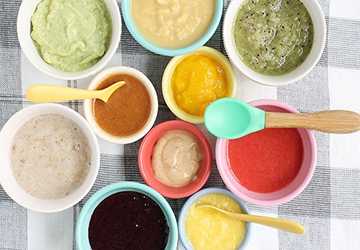Making Your Own Baby Food- A How-To
Embarking on the noble quest of concocting your progeny's sustenance from the sanctity of your domicile is not merely a gratifying endeavour but also a cardinal leap towards ensuring your offspring basks in a healthful, eclectic diet carefully tailored to their nuanced dietary predilections. This exhaustive manual will shepherd you through the comprehensive spectrum of nuances essential for the artisanal creation of infant nourishment at home, including the multifaceted benefits, elementary yet nutritious concoctions, and vital counsel to initiate your expedition.

The Intrinsic Advantages of Bespoke Infant Nourishment
To commence, let us explore the vast panorama of benefits associated with bespoke infant nourishment. The artisanal preparation of your infant's meals within the confines of your hearth can bestow an array of helpful benefits:
● Nutrient-Density: Artisanally curated infant food inherently tends to be fresher and less adulterated, thereby enabling the custodian to meticulously oversee the quality whilst eschewing preservatives, excessive sodium, or sugars.
● Fiscal Prudence: The domestic fabrication of infant food can be more economically viable than the acquisition of commercially pre-packaged variants.
● Culinary Diversity and Gustatory Delight: Personal preparation allows for introducing a more extensive spectrum of flavours and textures, thus aiding in cultivating your progeny's gustatory preferences and receptivity towards diverse comestibles.
● Emotional Resonance: Crafting infant nourishment can engender a profound bond, directly involving your offspring's nutritional and holistic welfare.
Embarking on the Homemade Infant Nutrition Journey
Before delving into DIY baby food recipes, it is paramount to acquaint oneself with the foundational principles and ensure you are thoroughly prepared for this venture.
Quintessential Apparatus
● An exceptional quality blender or food processor
● A steaming apparatus
● Ice cube moulds to freeze portions.
● Non-toxic, BPA-free storage vessels
Selection of Ingredients
In making homemade baby food, it is advisable to opt for organic produce wherever feasible to mitigate exposure to pesticides, aiming for a mosaic of fruits, vegetables, grains, and proteins to ensure a well-rounded diet.
Fundamental and Nourishing DIY Baby Food Recipes
DIY baby food recipes can range from the rudimentary to the intricate, depending on your inclination. Herein are several essential recipes to inaugurate your journey:
● Apple and Pear Puree: Meticulously peel, core, and segment apples and pears. Steam until tender, then amalgamate to achieve a silky consistency.
● Sweet Potato and Carrot Mash: Delicately peel and dice sweet potatoes and carrots. Steam and amalgamate for a delightfully nutritious puree.
● Pea and Spinach Fusion: Steam peas and spinach, then puree to an acceptable homogeneity. This verdant concoction is a veritable bastion of iron and protein, making it an excellent foray into verdant nutrients.
Progressively introducing singular ingredients and vigilantly observing for any signs of allergic responses is crucial.
The Boons of Tailor-made Infant Sustenance
The benefits of homemade baby food are profound and diverse. From the assurance of precisely knowing the constituents of your infant's diet to the economic benefits, the merits are unequivocally palpable. Moreover, homemade meals can be meticulously tailored to align with your baby's taste preferences and nutritional exigencies—a feat unattainable with store-bought options.

Preservation and Freezing of Artisanal Baby Food
Having mastered making homemade baby food, reasonably storing such culinary creations is paramount. Purees can be efficiently frozen in ice cube trays and transferred to freezer bags for facile portioning. It is imperative to inscribe these bags with labels and dates meticulously. Frozen baby food remains viable for consumption for up to three months.
Blueprints for Success
● Singularly introduce new edibles and diligently monitor for allergic manifestations.
● Initiate with monocomponent purees before progressing to multifaceted mixtures.
● Employ breast milk or formula to adjust the consistency of purees as necessitated.
Innovative Pairings for Nutritional Equilibrium
● Avocado and Banana Concoction: Merge succulent avocado with ripe banana to craft a luscious, nutrient-dense repast. This amalgamation is replete with healthful fats and potassium, indispensable for cerebral and muscular vitality.
● Beetroot and Blueberry Fusion: Steam beetroot and amalgamate with blueberries for an effervescent, antioxidant-laden puree. The innate sweetness in both components renders this concoction a winsome initiation to the realm of vegetables.
● Quinoa and Peach Delight: Harmonized quinoa mingled with pureed peach offers a captivating texture and is an exemplary source of protein and dietary fiber.
Seasonal Nourishment: Leveraging the Cornucopia of Nature
Tailoring your infant nutrition recipes to capitalize on seasonal produce guarantees freshness and acquaints your offspring with the ethos of seasonal consumption. This methodology fosters a trajectory towards sustainable dietary habits and cultivates an appreciation for a diverse spectrum of edibles as they mature.
Ideas for Seasonal Culinary Creations:
● Spring: A puree of freshly harvested peas and mint, offering a rejuvenating and zesty gastronomic delight.
● Summer: A blend of watermelon and cucumber, serving as a hydrating and cooling repast.
● Autumn: Pumpkin and apple puree, subtly enhanced with a whisper of cinnamon, invoking a sense of warmth.
● Winter: Mashed sweet potato infused with thyme, delivering a solace-filled and robust fare.
The Essence of Herbs and Spices in Infant Cuisine
Infusing mild herbs and spices into infant meals is a splendid strategy to augment flavour without resorting to salt or sugar. Cinnamon, nutmeg, and turmeric can be gently introduced in minuscule quantities, presenting a soft initiation into the global tapestry of flavours.
Herbaceous and Spiced Inspirations:
● Carrot and Ginger Puree: A hint of ginger revitalizes a straightforward carrot puree, infusing it with vibrancy and piquancy.
● Apple with Cinnamon: Cinnamon introduces a nuanced complexity to simmered apples, crafting a snug and inviting fare.
Advocating Autonomy: The Path to Self-Feeding
Novice Finger Foods:
● Steamed carrot sticks or zucchini batons are chilled and designed for easy grasping.
● Mellow, ripe pear or peach slices facilitate an introductory self-feeding journey.
● Petite, tender segments of chicken or fish, meticulously cooked and effortless to masticate.
Conclusion
Preparing your infant's nourishment is a laudable pursuit that promises enduring benefits for your child's health and dietary habits. Armed with these DIY baby food recipes, insights, and a profound understanding of the benefits of homemade baby food, you are adeptly equipped to create nutritious, palatable meals that your infant will relish.











